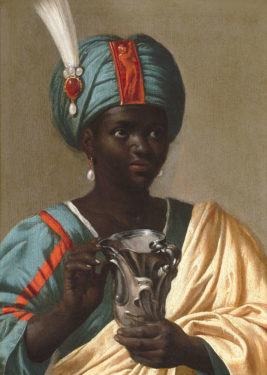In fine art, the term “Orientalist Painting” refers to the depiction of present-day Turkey, Greece, North Africa, and the Middle East by Western artists. The architecture, customs, and individuals of these exotic locales have fascinated artists for centuries, even appearing in paintings as early as the Renaissance and slightly later in works of the Dutch Golden Age. The Orientalist movement gained massive popularity during the 19th century following Napoleon’s military campaign in Egypt and the subsequent publication of Description de l’Egypte, a 24-volume set illustrating the geography, architecture, and customs of Egyptian North Africa.

This remarkable portrait by the Dutch master Jan van Bijlert depicts a North African model as Caspar, one of the three Magi
Of all Orientalist themes, no subject was more prevalent or influential than the harem, especially scenes featuring one or more odalisques. Typically, odalisques were depicted as erotic slave-concubines; however, this was simply not so! In fact, “odalisque” is a French term originally derived from the Turkish odalik meaning “chambermaid.” Today, the word odalisque is synonymous with any lounging female nude, regardless of ethnicity.
Since Western males would not have been admitted into an authentic seraglio (harem), it is safe to assume that the harem as depicted in Western fine art is a fictional, idealized place based upon hearsay, other representations of the subject, and the artist’s own imagination. This fact is illustrated quite humorously in Georges Vibert’s The Peeping Roofers and the Woman’s Bath.
The playful composition depicts three men (one a clever self-portrait of the artist) peeking through a hole in the roof down into a woman’s bath below. The “private” interior is filled with ladies “splashing about or taking refreshments, in a luxuriously decorated hummum fit for the Arabian Nights.” In fact, the composition combines elements of several cultures—the bath is exquisitely decorated with Turkish architecture and carpets while the female subjects are clothed in contemporary Western dress and Japanese geta and silk kimonos. The watercolor and gauche painting clearly demonstrates the Western world’s obsession with the exotic Orient and even more so, the Western male artist’s desire to observe that which he is not allowed to enter, the harem.

The remarkable work, which was commissioned by the American shipping and railroad magnates, the Vanderbilts, was recently on loan at the Flagler Museum in Palm Beach, FL for inclusion in their exhibition Harem: Unveiling the Mystery of Orientalist Art.
Orientalist genre scenes—particularly depicting the harem and beautiful odalisques—continued to inspire artists well into the 20th century. Artists including Auguste Renoir, Paul Klee, and Pablo Picasso each took up Orientalist themes, but chief among these was Henri Matisse.
Matisse’s infatuation with Orientalist subjects, most notably odalisques, can be traced to a seven-month visit to Morocco from 1912 to 1913 during which the artist produced approximately 24 paintings and numerous drawings. Matisse continued to revisit the subject of the odalisque throughout the remainder of his artistic career, but they appear most frequently during the first decades of the 20th century.
One such work is Femme Nue Assise, a pencil on paper drawing dated 1931. In this study, a nude female sits languidly on the floor with her hand placed upon a cushion; the model’s pose and direct gaze are confident. She is clothed only by loosely draped fabric which exposes her left breast and the exotic jewelry adorning her wrists, upper arms, and neck. Stripped of the vibrant color for which Matisse is best known, the straightforward line drawing is a remarkable example of the artist’s incomparable elegance of composition and enduring fascination with the female form.





